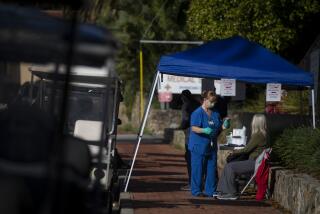King Hospital Turned Corner, Now Public Support Must Build : Health Care: Bare-bones budgets fail to allow the compassionate support required for good treatment programs on many levels.
- Share via
Due to the heroic efforts of its staff and a one-time financial boost from Los Angeles County, Martin Luther King Jr./Drew Medical Center last month made a stunning turnaround, enabling it to meet federal hospital accreditation requirements. Now that we at King/Drew can catch our breath, we have a chance to develop a rational plan for this vital Los Angeles facility.
During the recent controversy over patient care, it became apparent that losing the medical center would have a devastating impact on the entire Los Angeles region. Private health companies did not want to take over the hospital because they did not think that it was economically viable. Yet area hospitals feared a domino effect if King/Drew were to close, since they would be forced to pick up the large number of inadequately reimbursed services. Closing the facility would have denied the community its largest employer and economic asset. On a larger scale, one of the nation’s three largest sources of health-care providers for under-served regions would be lost.
Last month, the president of the hospital university, Dr. Walter F. Leavell, was brought to the medical center as an unconscious and critically injured “John Doe” after an auto accident. He received superb care because trauma is one of the fields in which our staff’s performance is unsurpassed. As you journey along the freeways of Los Angeles, or even the streets of its affluent communities, you should hope that we at King/Drew solve our problems, because you might need to be brought here.
While the recent recent flood of publicity did some good, we need more public attention to get changes in state and federal laws that will ensure our survival. It is unfortunate that the new method for government intervention in the health-care sector is to release questionable mortality statistics to the media. Medical centers that care for populations that are young, employed and generally healthy have lower mortality rates, whether perinatal, surgical or medical. But there is no scientifically valid way to factor in the impact of the risk factors associated with urban poverty or chronic disease.
We have a long way to go. Stand with us here in the pediatric emergency room on a typical morning. You will see 13 critically ill children in a work space designed for four. Two pediatric teams are carrying out heroic life-support measures. Nurses and physicians are telephoning for beds in other hospitals because half of ours are not available. Somehow, all of these patients will receive care, but more personnel, beds and equipment are desperately needed.
We at King/Drew know from our own morbidity and quality-of-care studies that we have deficiencies in both medical and human-support services. There is a shortage of trained personnel to manage the intensity of illness found only in inner-city hospitals. Nurses and physicians working in these hectic units often cannot take the time to upgrade professional skills through continuing education. Bare-bones budgets fail to allow the compassionate support required when illness becomes chronic or terminal, or when patients are the victims of violence.
We cannot carry out the complicated care required by our clinical caseload without medical-specialty training programs, which are in constant jeopardy because accreditation bodies demand that residents care for more chronic-disease patients and fewer of those with acute illnesses. Our medical center has a very heavy case load of acutely ill patients. In order to meet the demands of patients and review boards, we must expand our medical staff, facilities and support services.
Funds most come from higher rates of reimbursement to cover the actual costs of providing services. Medicaid and Medicare should reimburse King/Drew and all hospitals caring for high-risk populations at proportionately higher rates than those serving lower-risk populations.
Perhaps the recent increase in public awareness about King/Drew will help bring in more philanthropic and volunteer support. We need foundation aid for compassionate support services. Volunteer physicians are needed to extend the reach of our hard-pressed attending staff. An expanded hospital auxiliary would improve communication, funding and courtesy.
When the children we invited you to observe are eventually admitted, cured and discharged from the hospital, few will return to secure homes in economically healthy communities, supportive neighborhoods or classrooms that prepare them for productive lives. Fundamental changes are needed in their inner-city environment if we are to cut hospital caseloads or excessive morbidity and mortality rates in the local population.
We are grateful to various private philanthropic and government agencies that have helped in addressing this problem. With the medical center as anchor, we have been able to extend basic services to many tens of thousands of youngsters in child care, education and employment training, as well as health. For their sakes, we hope that there is, indeed, an increased public appreciation of our essential role in the Los Angeles medical community and that both they and we will have a brighter future.






